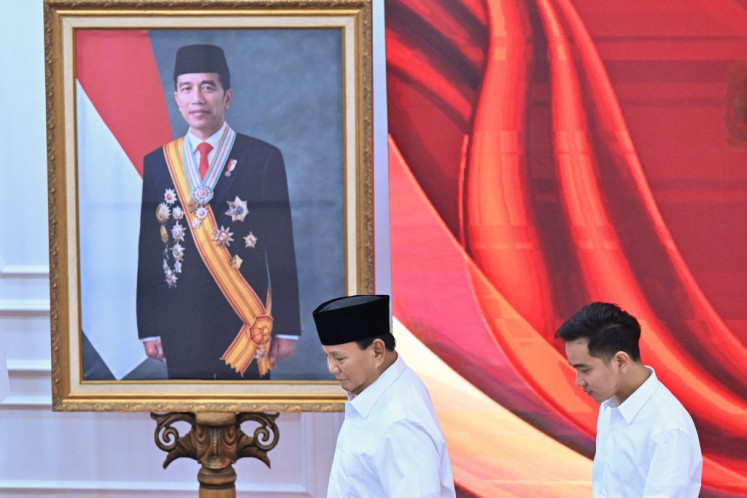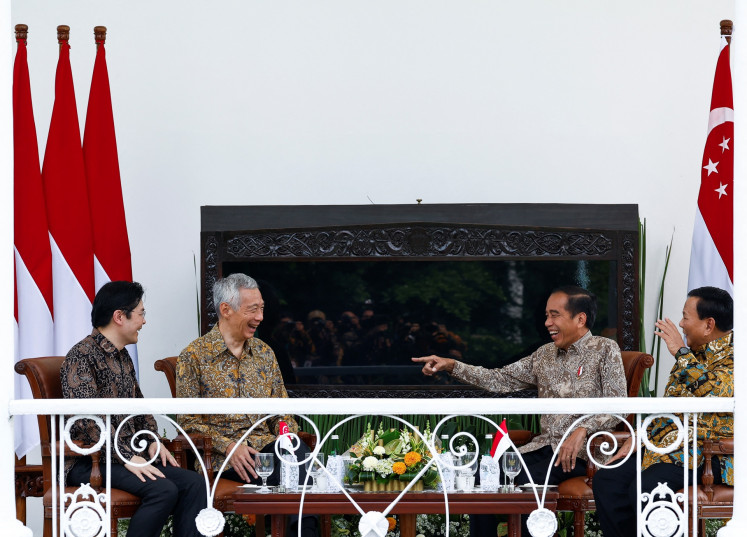Six key trends to watch in 2023
India is expected to overtake Japan and Germany to become the world's third largest economy by 2030.
Change Size
 A bicycle rider passes an electronic quotation board displaying share prices of the Tokyo Stock Exchange (2nd L) and numbers of Asian markets in Tokyo on September 17, 2020. (Agence France Presse/Kazuhiro Nogi)
A bicycle rider passes an electronic quotation board displaying share prices of the Tokyo Stock Exchange (2nd L) and numbers of Asian markets in Tokyo on September 17, 2020. (Agence France Presse/Kazuhiro Nogi)
T
he ongoing COVID-19 pandemic, geopolitical shocks and sustained inflation are expected to persist as the main risks in 2023, but Asia is likely to be a bright spot amid intensifying headwinds as the region’s resilience is once more on display.
In particular, the reopening of China’s borders and the recovery of consumption in the mainland are expected to boost the economy, while India and ASEAN will further expand their growth potential.
Here are the six key trends to watch this year.
1. Geopolitics is reshaping the global industrial chain
The world is observing the impact of the Russian-Ukrainian war. If this conflict continues, in addition to bringing about a humanitarian crisis, it may trigger new energy and food crises, push up inflation, exacerbate supply chain bottlenecks, and expand geopolitical risks.
Additionally, a trade war between China and the United States erupted in 2018, and now technology is at the center of that skirmish. In coming years, the restrictions on bilateral trade and investment between the two countries will continue, and to expand in core technology further -- such as semiconductors, 5G, batteries, and key minerals and materials -- will mean the global industrial chain will be finding a new balance between cost, safety, technical standards and policies.
2. An opportunity to accelerate the energy transition
The global energy crisis triggered by Russia’s invasion of Ukraine is causing profound and long-lasting changes that have the potential to hasten the transition to a more sustainable and secure energy system, particularly the generation of sustainable energy, innovative storage solutions and more sustainable energy consumption.
The transformation will require huge investment and support from capital markets. Private investors will play an important role in augmenting government funding. In the long run, the transformation of the energy system will create an industrial chain based on new energy and new technology which boosts economic growth and creates more employment opportunities. However, this gigantic project cannot be accomplished overnight, and will depend on the long-term cooperation of various industries and stakeholders in society.
For example, nickel demand for batteries, especially the kind used in electric vehicles (EVs), is growing rapidly. Indonesia is the world’s largest nickel producer with the largest nickel reserves and is well positioned to move up the supply chain with multiple EV battery investment projects already in the pipeline.
3. Financial technology will drive future growth
The resilience brought to enterprises by digitalization has been fully demonstrated during the COVID-19 pandemic and will continue to be at the core of business strategies. Global financial technology will usher in new changes, including central bank digital currencies (CBDC) and virtual assets, which will not only improve the customer service experience but also bring more business opportunities to enterprises.
Meanwhile, virtual assets should be properly regulated like stocks, bonds and other asset classes as more investors consider them as a vehicle for asset allocation. Especially when virtual assets are invested in different types of projects, the various risks posed by them must be accompanied by regulation.
4. India and ASEAN economies will be bright spots in global growth
Driven by the transfer of manufacturing, digitalization, energy transformation, and the upgrading of the service industry, India is expected to overtake Japan and Germany to become the world's third largest economy by 2030. Meanwhile, India’s population is set to hit 1.425 billion in April this year, ranking as the world’s most populous country, according to the United Nations Population Fund. This means that a new generation of young Indians will become the largest source of consumers and labor in the digital economy.
In Southeast-Asia, auto manufacturing, consumer electronics, renewable energy, e-commerce, and financial technology will be key areas of growth in the region. This comes on the heels of Vietnam becoming the second largest e-commerce market in Southeast Asia by 2025 with with a market size of US$39 billion, three times the estimated total of $13 billion in 2021.
5. China’s economy expected to recover gradually
Although there are still variables in the waves of COVID-19, the reopening of mainland China and more comprehensive policies to support the real estate industry will be driving forces supporting the recovery of growth.
In December last year, the Central Economic Work Conference regarded “expanding domestic demand” as the top priority, including increasing the income of urban and rural residents, improving housing and elderly care services, and producing more electronic vehicles. This will help restore consumer confidence, ease supply chain bottlenecks, and boost economic activity.
The rebound in mainland consumer demand is expected to further boost major exporters such as Indonesia, Malaysia, Thailand, and Singapore. The Regional Comprehensive Economic Partnership Agreement (RCEP) will drive increased trade between China and ASEAN, and the digital economy will also become a backbone for trade.
6. More intense competition for talent
The “Great Resignation” that has emerged since COVID-19 is not just focused on the the financial sector but is a common challenge faced by sectors and countries around the world. In 2023, the competition for talent among countries will become more intense, as many multinational companies aim to expand their global business, and different economies launch preferential policies to attract these companies and their talent.
The Hong Kong SAR government's competition for enterprises and talent is one such of these. The business world should take a step forward in retaining and training talent, particularly in financial technology and combating climate change.
As the global recovery continues in 2023, a bumpy road still lies ahead. We are confident that the economic downturn cycle can highlight potential areas for economic growth and opportunities within your business.
***
The writer is co-chief executive, Asia-Pacific, at HSBC.










